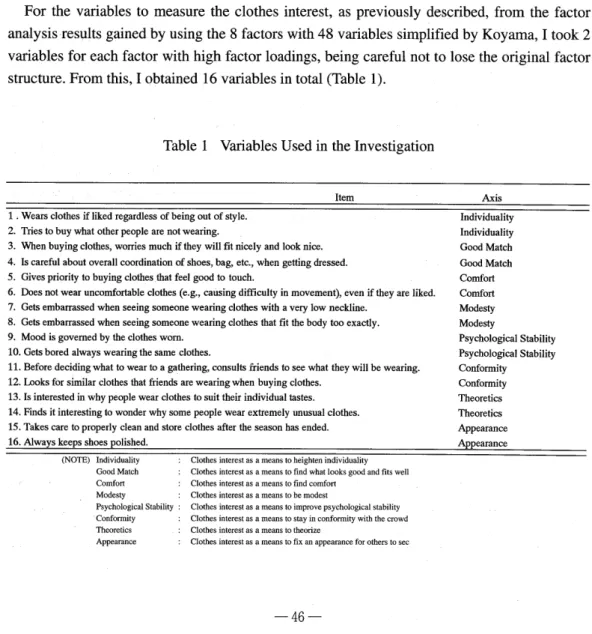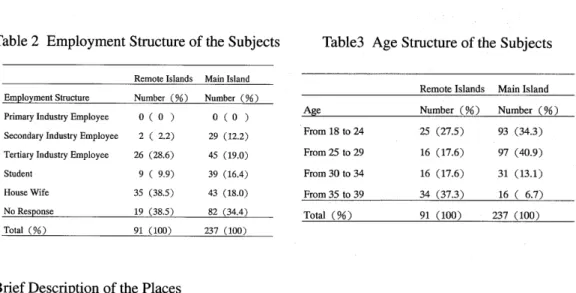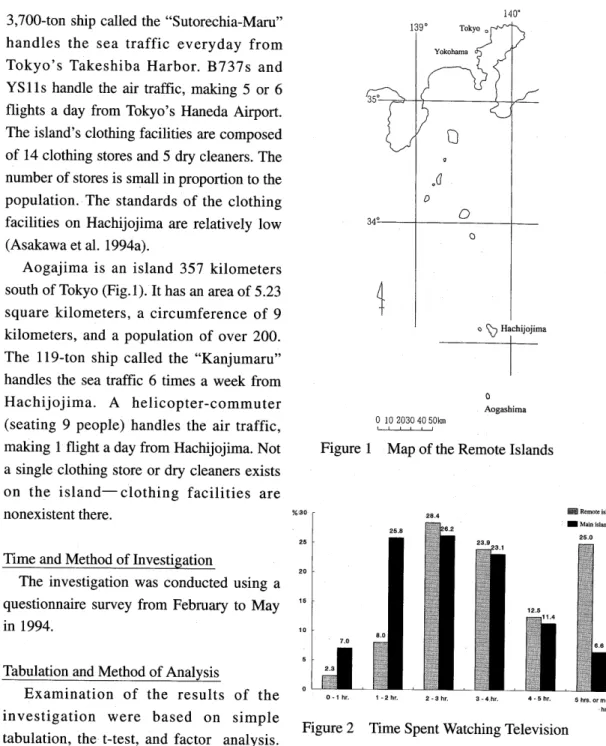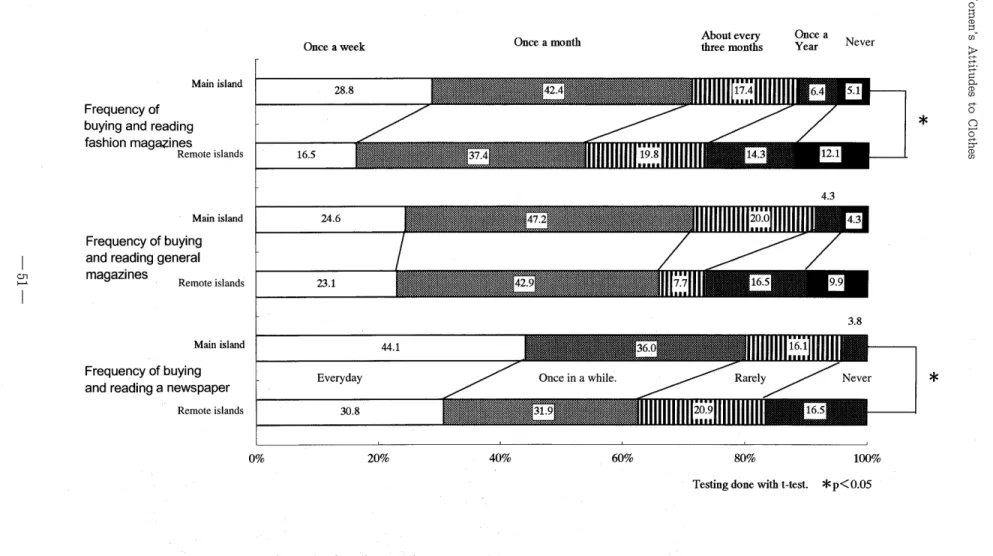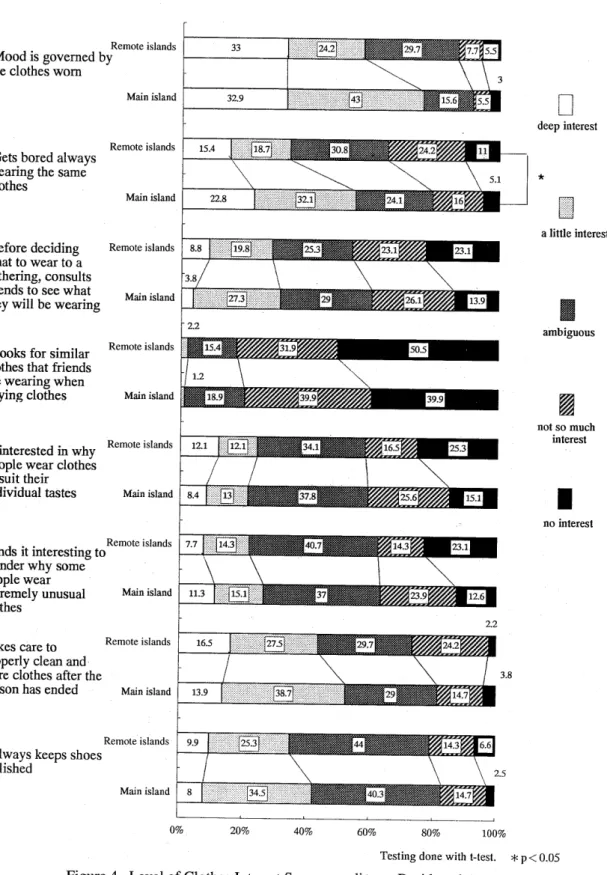文教 大 学女 子短期 大学 部研 究紀要44集,45-60,2000
女性 の被服 に対す る態度
浅 川 雅 美*
Women's Attitudes to Clothes
A Comparison between the Main Island of Japan and
the Remote Islands of Japan
Masami Asakawa
Introduction
I planned this study to observe the characteristics of women's attitude to clothes (women's clothes interest) on the remote islands in comparison with that of the main island . I examined a method to measure the characteristics that can be called "the degree of "women's clothes interest" on both the main island and the remote islands.
The "clothes interest" concept is very extensive, and is intrinsically impossible to metrically define it completely. Therefore, I had to adopt a method to prepare a measurable scale (variables) with which I could operationally make the definitions and the measurements. In the scale that I prepared, various cultural elements such as race, region, religion, and economics naturally influence the measurements. The differences between the groups are many, but without a constant operational definition, the characteristics cannot be measured.
In the past, Creekmore compiled the "Importance of Clothing Questionnaire ," which contained 9 axes (factors) with 89 variables (Creekmore 197 1). Then, Gurel et al. (L.M.Gurel, L.Gurel 1979) used Creekinore's "Importance of Clothing Questionnaire" on 500 university students (80 male, 420 female) in the USA, conducted factor analysis with the data obtained , and clarified the concept called "clothes interest." In other words, they verified some of the basic factors of the clothes interest. On the other hand, Koyama (1983) used Creekinore's "Importance of Clothing Questionnaire" (89
variables) on 209 working women in Japan, aged 19 to 50 years old. He conducted factor analysis with the data obtained, deleted 4 variables with factor loading of 0.3 or less, and compressed the number of variables to 85 . He then conducted further factor analysis with the 85 variables, extracting 8 factors. Then he selected 6 variables each from the variables that indicated high factor loading for each factor . With that, he compiled the Japanese version of the "Questionnaire of Clothes Interest ," simplified to 8 factors with 48 variables. Regardless of the differences in race, culture , age, and sex, it
*ラ イ フ デザ イ ン学 科 専 任 講 師
45-60, 2000
became clear that the results of Koyama's investigation in Japan had approximately the same scales (variables) and combinations as the results of the investigation done on university students in the .USA. That verifies the existence of important information to measure the degree of clothes interest within the factors and variables adopted by Gurel, Koyama, et al.
With this thesis for measuring the degree of clothes interest, from among the 8 factors (48 variables) simplified by Koyama, I took 2 variables for each factor which had high factor loading, being careful not to lose the original factor structure. From this, I obtained 16
variables in total. Using these, the object of our investigation was to examine the
characteristics of the clothes interest held by the women on the remote islands by making a comparison with the differences of the clothes interest held by the women on the main island.
Methods
Setting the Variables
For the variables to measure the clothes interest, as previously described, from the factor
analysis,results gained by using the 8 factors with 48 variables simplified by Koyama, I took 2
variables for each factor with high factor loadings, being careful not to lose the original factor structure. From this, I obtained 16 variables in total (Table 1).
Table I Variables Used in the Investigation
Item Axis
1 . Wears clothes if liked regardless of being out of style. 2. Tries to buy what other people are not wearing.
3. When buying clothes, worries much if they will fit nicely and look nice. 4. Is careful about overall coordination of shoes, bag, etc., when getting dressed. 5. Gives priority to buying clothes.that feel good to touch.
6. Does not wear uncomfortable clothes (e.g., causing difficulty in movement), even if they are liked. 7. Gets embarrassed when seeing someone wearing clothes with a very low neckline.
8. Gets embarrassed when seeing someone wearing clothes that fit the body too exactly. 9. Mood is governed by the clothes worn.
10. Gets bored always wearing the same clothes.
11. Before deciding what to wear to a gathering, consults friends to see what they will be wearing. 12. Looks for similar clothes that friends are wearing when buying clothes.
13. Is interested in why people wear clothes to suit their individual tastes. 14. Finds it interesting to wonder why some people wear extremely unusual clothes. 15. Takes care to properly clean and store clothes after the season has ended. 16. Always keeps shoes polished.
Individuality Individuality Good Match Good Match Comfort Comfort Modesty Modesty Psychological Stability Psychological Stability Conformity Conformity Theoretics Theoretics Appearance Appearance (NOTE) Individuality Good Match Comfort Modesty Psychological Stability Conformity Theoretics Appearance Clothes Clothes Clothes Clothes Clothes Clothes Clothes Clothes
nterest as a means to heighten individuality merest as a means to find what looks good and fits well merest as a means to find comfort
nterest as a means to be modest
nterest as a means to improve psychological stability merest as a means to stay in conformity with the crowd merest as a means to theorize
Women's Attitudes to Clothes
The interpretation of those 8 factors is as follows:
Clothes interest as a means to heighten individuality
Clothes interest as a means to improve psychological stability
Clothes interest as a means to find what looks good and fits well Clothes interest as a means to stay in conformity with the crowd
Clothes interest as a means to find comfort
Clothes interest as a means to theorize
Clothes interest as a means to be modest
Clothes interest as a means to fix an appearance for others to see.
These 16 variables cannot totally reproduce all of the information space set up by the 89 variables proposed by Creekmore and the 48 variables compiled by Koyama. But I thought that they were necessary and indispensable variables to compare the clothes interest on the remote islands with that on the main island. With this further simplified and clarified information space as the target of consideration, further factor analysis of these carefully selected variables and the comparison of both groups can extract a more comprehensive meaning than analyzing the 89 or 48 variables. Furthermore, I divided the reply category into 5 steps.
Subject of Investigation
I investigated 91 women between 18 to 39 years old living on the remote islands of Tokyo, Hachijojima and AogaJima, which are included in Tokyo's administration. (79 on Hachijojima and 12 on AogaJima). I also investigated 237 women between 18 to 39 years old living in or around Tokyo. Tables 2 and 3 show theiroccupation and age breakdowns.
Table 2 Employment Structure of the Subjects Table3 Age Structure of the Subjects
Remote Islands Main Island
Remote Islands Main Island
EmDlovment Structure Number (%) Number (%)
Primary Industry Employee Secondary Industry Employee Tertiary Industry Employee Student House Wife No Resnonse 0 0 ) 2 2.2) 26 (28.6) 9 ( 9.9) 35 (38.5) 19 (38.5) 0 ( 0 ) 29 (12.2) 45 (19.0) 39 (16.4) 43 (18.0) 82 (34.4)
Age Number (%) Number (%)
From 18 to 24 From 25 to 29 From 30 to 34 From 35 to 39 25 (27.5) 16 (17.6) 16 (17.6) 34 (37.3) 93 (34.3) 97 (40.9) 31 (13.1) 16 ( 6.7) Total M 91 (100) 237 (100) Total (%) 91 (100) 237 (100)
Brief Description of the Places
Hachijojima is an island 291 kilometers south of Tokyo (Fig.1). It has an area of 69.52 square kilometers, a circumference of 58.91 kilometers, and a population of over 9 ,500. The
45-60, 2000
3,700-ton ship called the "Sutorechia-Maru" handles the sea traffic everyday from Tokyo's Takeshiba Harbor. B737s and YS I Is handle the air traffic, making 5 or 6 flights a day from Tokyo's Haneda Airport. The island's clothing facilities are composed of 14 clothing stores and 5 dry cleaners. The number of stores is small in proportion to the population. The standards of the clothing facilities on Hachijojima are relatively low (Asakawa et al. 1994a).
Aogajima is an island 357 kilometers south of Tokyo (Fig. 1). It has an area of 5.23
square kilometers, a circumference of 9
kilometers, and a population of over 200. The 119-ton ship called the "Kanjumaru" handles the sea traffic 6 times a week from
Hachijojima. A helicopter-commuter
(seating 9 people) handles the air traffic, making I flight a day from Hachijojima. Not a single clothing store or dry cleaners exists
on the island-clothing facilities are
nonexistent there.
Time and Method of Investigation
The investigation was conducted using a questionnaire survey from February to May in 1994.
Tabulation and Method of Analysis
Examination of the results of the
investigation were based on simple
tabulation, the t-test, and factor analysis. The analysis was
computer center.
Figure I Map of the Remote Islands
Figure 2 Time Spent Watching Television
done with the "SPSSx Statistics Package" at the University of Tokyo's
Results and Discussion
Availability of Everyday Life Information 1. Time Spent Watching Television
Women's Attitudes to Clothes
Figure 2 shows the average daily time spent watching television. A significant difference existed between the averages of the remote islands and the main island, where the statistical significance was tested at the level of 0.05. More time is spent watching television on the remote islands than on the main island. It was an especially remarkable characteristic that 25% of the remote islanders watched television for at least 5 hours. From that , I can suppose that the remote island inhabitants, having relatively few opportunities for other entertainment , are more dependent on television.
2. A newspaper and Magazines Subscription Situation
Figure 3 shows the results of the survey regarding the buying and reading of a newspaper and magazines. From the Figure , it can be seen that, compared to the main island , fewer remote island inhabitants buy and read a newspaper everyday. On the remote islands , much of the resources for living, including the newspaper, are carried in by ship. But when conditions
such as bad weather prevent the ship from arriving in the harbor, the newspaper is not
delivered. Dependence on newspapers for the latest news remarkably decreases when no
recent news can be obtained from them. Figure3 shows no significant difference with general
magazines as compared to the main island inhabitants. However, fewer remote island
inhabitants read fashion magazines compared with the main island inhabitants . This is
probably because the number of bookstores on the remote islands is remarkably smaller than on the main island, and that the selection in those bookstores is small (Asakawa et al. 1994a) .
It was found that the time spent watching television, which is of the telecommunication media system, on the remote islands is remarkably longer than on the main island. I also found that number of people buying and reading newspapers and magazines, which are of the print media system, was smaller. It can be thought that those results indicate that geography forces
the receiving of print media system information to be low and forces the receiving of
telecommunication media system information to be high on the remote islands .
Clothes Interest According to Residential Area
Figure 3 shows the results of the questions about the clothes interest. Testing the differences of the averages of the remote islands and the main island, there was a significant difference ,
which was tested at the level of 0.05, in the following variables: "Concern with overall
coordination including shoes, handbag, etc., when getting dressed" and "Getting tired of
wearing the same clothes all the time." In other words, compared to the remote islands , more
women on the main island were "concerned with overall coordination when getting dressed
and get tired of wearing the same clothes all the time." Some reasons for this could be that on the remote islands,
There are but a few stores selling goods such as clothes, shoes, and handbags , and the goods themselves are scarce (Asakawa et al. 1994a).
They spend much time watching television, but do not receive much information
45-60, 2000
from other media such as newspapers or magazines. Not many people buy and read fashion magazines.
Factor Structure of Clothes Interest
A factor analysis was conducted to examine how the remote islands and main island women .are subconsciously concerned with clothing.
1. Women on the Remote Islands
Correlation between the 16 variables were computed, and factor extraction was
accomplished by means of the principal components method. Five factors were obtained. The percentage of variance explained was 64.3%. Next, the varimax rotation was performed to make the factors easier to interpret. Table 4 shows the results.
In Factor 1, the follwing showed high factor loading: Always keeps shoes polished.
Takes care to properly clean and store clothes after the season has ended. Gives priority to buying clothes that feel good to the touch.
Does not wear uncomfortable clothes (e.g., causing difficulty in moving), even if they are appealing.
Is careful about overall coordination of shoes, bag, etc., when getting dressed.
The above point can be interpreted to be the "cleanliness and practicability factor." In Factor 2, the following showed high factor loading:
Gets embarrassed when seeing someone wearing clothes that fit the body too exactly. Gets embarrassed when seeing someone wearing clothes with a very low neckline.
Looks for similar clothes that friends are wearing when buying clothes.
The above can be interpreted to be the "consciousness of others and shame factor." In Factor 3, the following showed high factor loading:
Finds it interesting to wonder why some people wear extremely unusual clothes. Is interested in why people wear clothes to suit their individual tastes.
The above can be interpreted to be the "interest in individual differences and diversity
factor."
In Factor 4, the following showed high factor loading:
When buying clothes, worries if they will fit nicely and look nice. Mood is governed by the clothes worn.
Before deciding what to wear to a gathering, consults friends to see what they will be wearing.
The above can be interpreted to be the "appearance priority factor." In Factor 5, the following showed high factor loading:
- Tries to buy what other people are not wearing . ,
This can be interpreted to be the "individuality priority factor."
I
C-n
Main island
Frequency of buying and reading
fashion magazines
Remote islands
I Main island Frequency of buying and reading general magazines R
emote islands
Main island
Frequency of buying and reading a newspaper
Remote islands
3zft;k 4L ~( -T- MA t *AAIMZC-544A,
Wears clothes if liked regardless of being out of style
Tries to buy what other people are not wearing
When buying clothes, worries much if they will fit nicely and look nice
Is careful about overall coordination of shoes, bag, etc., when getting dressed
Gives priority to buying clothes that feel good to the touch
Does not wear uncomfortable clothes (e.g., causing difficulty i
n movement), even if they are liked
Gets embarrassed when seeing someone wearing clothes with a very low neckline
Gets embarrassed when seeing someone wearing clothes that fit the body too exactly
Figure 4
45-60, 2000
Testing done with t-test. Level of Clothes Interest Seen according to Residental . Area
Women's Attitudes to Clothes
Mood is governed by the clothes wom
Gets bored always wearing the same clothes
Before deciding what to wear to a gathering, consults friends to see what they will be wearing
Looks for similar clothes that friends are wearing when buying clothes
Is interested in why people wear clothes to suit their individual tastes
Finds it interesting to wonder why some people wear extremely unusual clothes
Takes care to properly clean and store clothes after the season has ended
R
R
Always keeps shoes polished
Figure 4 Level of Clothes Interest Seen according to Residental Area
-53-I
Table 4 Result of Factor Analysis of Remote Islands (Based on the Pattern Matrix after the Varimax Rotation)
Items (Axis) Fac.1 Fac.2 Fac.3 Fac.4 Fac.5 Com-munality
Always keeps shoes polished.
Takes care to properly clean and store clothes after the season has ended. Gives priority to buying clothes that feel good to the touch.
Does not wear uncomfortable clothes (e.g., causing difficulty in movement), even if they are liked. Is careful about overall coordination of shoes, bag, etc., when getting dressed.
Gets embarrassed when seeing someone wearing clothes that fit the body too exactly. Gets embarrassed when seeing someone wearing clothes with a very low neckline. Looks for similar clothes that friends are wearing when buying clothes.
Finds it interesting to wonder why some people wear extremely unusual clothes. Is interested in why people wear clothes to suit their individual tastes.
When buying clothes, worries much if they will fit nicely and look nice. Mood is governed by the clothes worn.
Before deciding what to wear to a gathering, consults friends to see what they will be wearing.
Tries to buy what other people are not wearing. Wears clothes if liked regardless of being out of style. Gets bored always wearing the same clothes.
Appearance Appearance Comfort Comfort Good Match 0.708 0.659 0.542 0.515 0.683 0.198 0.126 0.021 -0.128 -0.149 0.096 0.259 -0 .071 0.803 0.784 0.445 -0.048 0.106 -0 .061 -0 .010 0.231 0.244 0.161 0.016 0.067 0.043 -0.067 -0 .033 0.341 0.024 0.041 0.056 0.098 -0.088 0.289 0.238 0.193 Modesty Modesty Conformity Theoretics Theoretics 0.016 0.045 -0 .037 0.515 0.455 0.422 0.299 0.531 0.706 0.679 0.188 -0.116 0.444 0.304 0.293 0.998 0.488 0.078 -0 .009 0.103 0.097 0.616 0.609 Good Match Psychological Stability Conformity Individuality Individuality Psychological Stability 0.052 0.108 -0 .057 0.016 0.003 0.224 -0.087 0.085 0.156 0.689 0.641 0.445 -0.147 0.245 0.137 0.312 0.451 0.211 0.153 0.104 0.078 0.132 0.076 0.100 0.219 0.014 0.062 -0.086 -0 .037 0.296 0.597 0.389 0.591 0.322 0.166 0.324 Eigenvalue 3.67 2.28 1.76 1.39 1.17 Pet of var. (% 22.9 14.3 11.1 8.7 7.3 64.3 CD CD CD
Women's Attitudes to Clothes
(1983), and the invariance of the factor structure of clothes interest was examined (Yoshida 1976, and Yanagiuchi 1990). When 2 variables which belonged to the same axes (factors) in Koyarna's study belonged to the same axes (factors) in this study too, it seemed that the invariance of the factor structure was high. Also, the more cases there were of 2 variables belonging to the same a xes, the higher the state of invariance of the factor structure. Conversely, it was observed that the fewer cases there were, the lower the state was of the invariance of the factor structure.
Variable combinations in Factor 1 listed in Table 2 were: 2 variables about "clothes interest as a means to fix an appearance for others to see," 2 variables about "clothes interest as a means to find comfort," and 1 variable about "clothes interest as a means to find what looks good and fits well."
Variable combinations in Factor 2 were: 2 variables about "clothes interest as a means to be modest," and 1 variable about "clothes interest as a means to stay in conformity with the crowd."
Variable combinations in Factor 3 were: 2 variables about "clothes interest as a means to theorize."
Variable combinations in Factor 4 were: 1 variable about "clothes interest as a means to find what looks good and fits well," I factor about "clothes interest as a means to improve psychological stability," and lvariable. about "clothes interest as a means to stay in conformity with the crowd."
Variable combinations in Factor 5 were: 2 variables about "clothes interest as a means to heighten individuality," and I variable about "clothes interest as a means to improve psychological stability."
In 5 axes (factors) out of Koyama's 8 axes (factors), 2 variables were allocated to the same factors. In Koyama's scale (1983), both variables about "clothes interest as a means to fix an appearance for others to see" and "clothes interest as a means to find comfort" belonged to Factor 1. Both variables about- "clothes interest as a means to be modest" belonged to Factor 2. Both variables about "clothes interest as a means to theorize" belonged to Factor 3. And both variables about "clothes interest as a means to heighten individuality" belonged to Factor 4.
Asakawa (1995b) conducted a similar survey on male and female junior and senior high school students on the main island and reported the following. In the case of the females:
In the case of the junior high school students, in 5 axes (factors) out of the 8 axes (factors) established by Koyama (1993), 2 selected variables were allocated to the same factors.
In the case of the senior high school students, in 7 axes (factors) out of the 8 axes (factors) established by Koyama (1993), 2 selected variables were allocated to the same factors.
From these results it could be interpreted that the invariance of the factor structure of the clothes interest rises when the children become senior high school students. Examining that report and the results of this study, it can be supposed that generally the invariance of the factor structure of the clothes interest rises with becoming a senior high school student, but
45-60, 2000
doesnot rise, even after the age of 18, on the remote islands .
2. Women on the Main Island
Extracting the factors with the same method as in the remote islands case , 6 factors were obtained for the women on the main island. The percentage of variance explained was 63 .5%. Next, the varimax rotation was performed to make the factors easy to interpret .Table 5 shows the results.
In Factor 1, the following showed high factor loading: Mood is governed by the clothes wom.
Gets bored always wearing the same clothes.
Is careful about overall coordination of shoes, bag, etc., when getting dressed . When buying clothes, worries a lot if they will fit nicely and look nice .
The above can be interpreted to be the "appearance priority factor ."
In Factor 2, the following showed high factor loading:
Gets embarrassed seeing someone wearing clothes with a very low neckline . Gets embarrassed seeing someone wearing clothes that fit the body too exactly .
The above can be interpreted to be the "consciousness of others and shame factor ."
In Factor 3, the following showed high factor loading:
Always keeps shoes polished.
Takes care to properly clean and store clothes after the season has ended . The above can be interpreted to be the "cleanliness priority factor."
In Factor 4, the following showed high factor loading:
Is interested in why people wear clothes to suit their individual tastes.
Finds it interesting to wonder why some people wear extremely unusual clothes .
The above can be interpreted to be the "interest in individual differences and diversity
factor."
In Factor 5, the following showed high factor loading:
Gives priority to buying clothes that feel good to the touch .
Does not wear uncomfortable clothes (e.g., causing difficulty in moving) , even if they are liked.
The above can be interpreted to be the "practicality priority factor ." In Factor 6, the following showed high factor loading:
- Looks for similar clothes that friends are wearing when buying clothes . This can be interpreted as the "desire to belong factor."
The invariance of the factor structure was examined in the same way as with the remote islands.
Variable combinations in Factor 1 were: 2 variables about "clothes interest as a means to
find what looks good and fits well," 2 variables about "clothes interest as a means to improve
psychological stability," and I variable about "clothes interest as a means to heighten
Table 5 Result of Factor Analysis of Main Island (Based on the Pattern Matrix after the Varimax Rotation)
Items (Axis) Fac.1 Fac.2 Fac.3 Fac.4 Fac.5 Fac.6 Com-munality Mood is governed by the clothes worn.
Gets bored always wearing the same clothes.
Is careful about overall coordination of shoes, bag, etc., when getting dressed. When buying clothes, worries much if they will fit nicely and look nice. Wears clothes if liked regardless of being out of style.
Psychological Stability Psychological Stability Good Match Good Match Individuality 0.634 0.549 0.591 0.581 -0.283 0.011 0.134 0.048 0.056 0.056 0.052 0.128 0.306 0.053 -0 .168 0.083 0.227 0.172 0.066 0.072 0.089 -0.037 0.163 0.248 0.188 0.167 -0.066 0.031 0.197 0.064 0.315 0.303 0.423 0.326 0.135 0 Cf) ~42 0 0
Gets embarrassed when seeing someone wearing clothes with a very low neckline. Gets embarrassed when seeing someone wearing clothes that fit the body too exactly.
Always keeps shoes polished.
Takes care to properly clean and store clothes after the season has ended.
Modesty Modesty 0.034 0.072 0.842 0.838 0.033 0.054 0.124 0.163 0.128 -0.096 Appearance Appearance 0.096 0.084 0.572 0.574 0.192 0.171 0.061 0.051 0.899 0.440 0.006 0.115 0.112 0.105 0.032 0.188 0.378 0.268
Is interested in why people wear clothes to suit their individual tastes. Finds it interesting to wonder why some people wear extremely unusual clothes. Tries to buy what other people are not wearing.
Theoretics Theoretics Individuality 0.151 0.109 0.234 0.131 0.222 0.118 0.058 0.029 0.177 0.847 0.455 0.263 0.167 0.026 0.124 0.029 0.260 -0.251 0.362 0.287 0.181
Gives priority to buying clothes that feel good to the touch.
Does not wear uncomfortable clothes (e.g., causing difficulty in movement),
Looks for similar clothes that friends are wearing when buying clothes. Before deciding what to wear to a gathering, consults friends to see what the
even if they are liked
y will be wearing. Comfort Comfort Conformity Conformity 0.030 0.344 0.025 0.069 0.082 0.145 0.139 -0.034 0.607 0.423 0.011 0.071 0.201 0.263 0.095 0.146 0.275 0.051 0.175 0.094 0.119 0.068 0.014 0.202 0.419 0.256 0.206 0.141 Eigenvalue 3.79 1.84 1.23 1.21 1.08 1.00 Pct of var. (% 23.7 11.5 7.7 7.5 6.7 6.3 63.5
45-60, 2000
Variable combinations in Factor 2 were: 2 variables about "clothes interest as a means to be
modest."
Variable combinations in Factor 3 were: 2 variables about "clothes interest as a means to
fix an appearance for others to see."
Variable combinations in Factor 4 were: 2 variables about "clothes interest as a means to
theorize," and 1 variable about "clothes interest as a means to heighten individuality ."
Variable combinations in Factor 5 were: 2 variables about "clothes interest as a means to find comfort."
Variable combinations in Factor 6 were: 2 variables about "clothes interest as a means to
stay in conformity with the crowd."
In this investigation, too, it was evident with the above results that , for the main island,in 7 axes (factors) out of the 8 axes (factors) established by Koyama (1983) , 2 selected variables were allocated to the same factors. These results were in accord with the results of Asakawa's investigation of the female high school students of the main island (1995b) , and they can be interpreted as high invariance of the factor structure.
The following were conjectured from the above results:
The results indicated that, for the main island, the clothes interest of the women is explained by 6 factors as compared to the 5 factors for the remote islands . From that, it was conjectured that the concern of the women on the main island for clothing is more diversified than that on the remote islands.
The results indicated that for the main island, 2 variables chosen in 7 out of 8 axes (factors) were allocated to the same factors, while for the remote islands, 2 variables chosen in only 5 out of 8 axes (factors) were allocated to the same factors. This means that, for remote island environments, the factor structure of the clothes interest has low invariance , even for women 18 years old or more.
Considering that Factor I is the factor subconsciously regarded as most important , it was conjectured that "cleanliness and practicability" are taken very seriously on the remote islands, and that "appearance" is taken very seriously on the main island .
Reference
Asakawa, M., Karube, M., and Ohsawa, S. (1994a). Shohi seikatsu kankyo no chiiki kakusa to sono hyoka [Regional Differences of Living Environment of Consumption and Its Measurement]. Journal of Home Economics of Japan, 45, 171-178.
Asakawa, M. (1 995b). Hifuku ni taisuru kachikan ga teichaku suru jiki [The Period of Fixing the Value on Clothing]. The Annual Reports of Studies of Bunkyo University
Women'sAttitudestoClothes
Creekmore, A. M. (197 1). Methods of Measuring Clothing Variab I es, (Michigan Agricultural Station Project No. 783). Michigan State University, East Lansing.
Koyama, S. (1983). Hifuku kanshindo no gainen to sono sokutei [The Concept of Clothing
Interest and Its Measurement]. Journal of the Japan Research Association for Textile EndUses, 24 (1), 27-33.
Gurel, L. M., and Gurel, L. (1979). Clothing Interest Conceptualization and Measurement. Home Economics Research Journal, 7 (5), 274-282.
Yanai, H. Shigemasu, S. Maekawa, S., and Ichikawa, M. (1990). Inshibunseki [Factor Analysis]. Tokyo: Asakura.
Yoshida M(l 976). Shinri tokeigaku [Psychological Statistics]. Tokyo: Maruzen.
麟
(謝 辞)
本 論 文 は 以 前 ま とめ た もの で あ る 。 ま とめ る に あ た っ て ご指 導 い た だ きま した 大 妻 女 子 大 学 人 間 生 活 科 学 研 究 所 の 大 澤 清 二 教 授 に 厚 く御 礼 申 し上 げ ます 。
